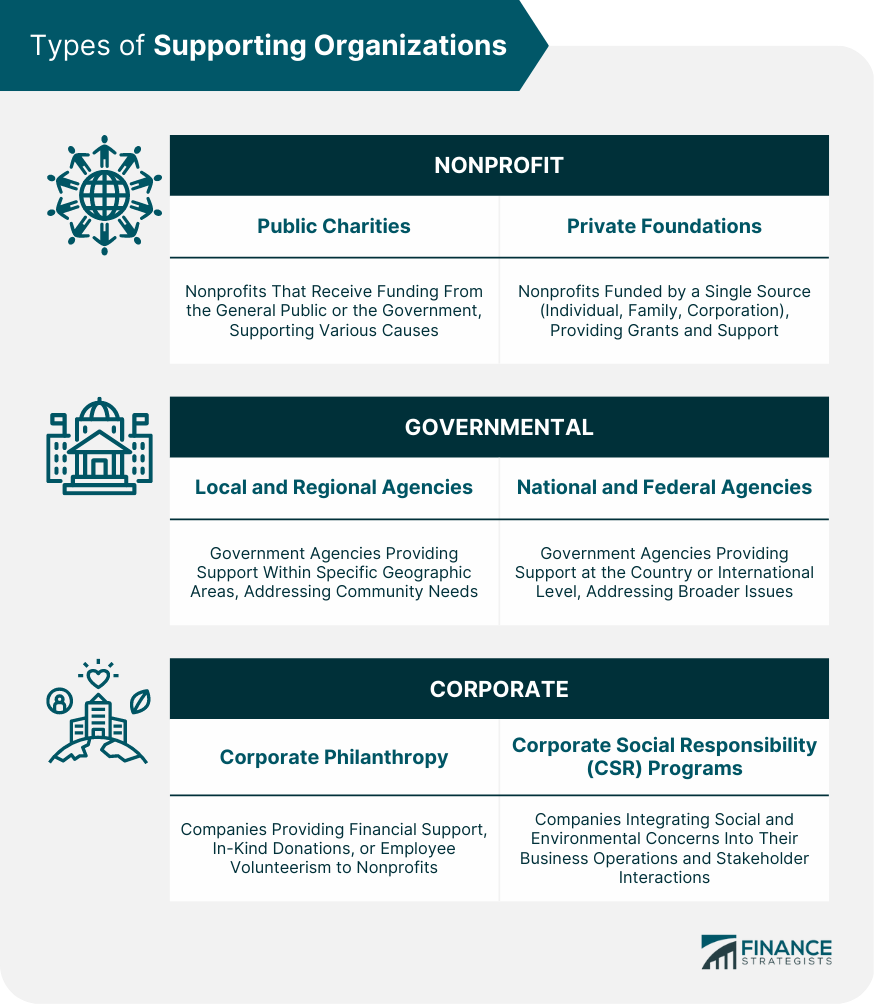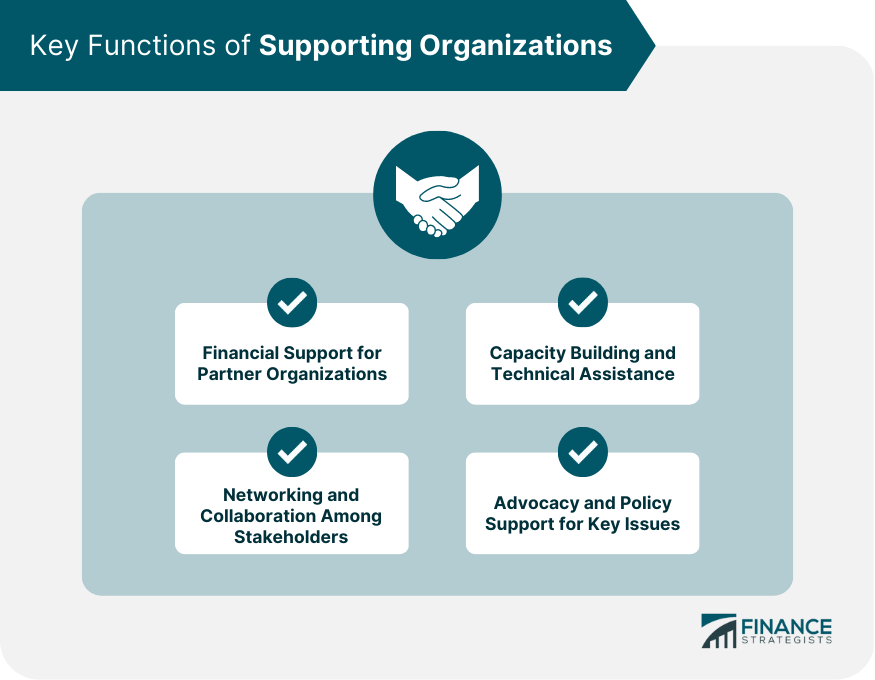Supporting organizations provide financial, technical, and operational assistance to other organizations, projects, or causes. They play a critical role in helping various sectors achieve their goals and objectives by offering resources, expertise, and networks. Supporting Organizations can take different forms, including nonprofits, governmental agencies, and corporations. Supporting Organizations play a vital role in sectors such as education, healthcare, environment, social services, and arts and culture. They help address societal challenges, drive innovation, and foster collaboration among stakeholders. By providing resources and expertise, Supporting Organizations enable other organizations to amplify their impact and create lasting positive change. Public charities are nonprofit organizations that typically receive the majority of their funding from the general public or the government. They provide support to various causes, including education, healthcare, poverty alleviation, and disaster relief. Examples of public charities include the American Red Cross, United Way, and Save the Children. Private foundations are nonprofits that typically derive their funding from a single source, such as an individual, family, or corporation. They provide grants and other types of support to organizations, projects, or initiatives that align with their mission. Examples of private foundations include the Bill & Melinda Gates Foundation, Ford Foundation, and Rockefeller Foundation. Local and regional governmental agencies provide support to organizations and initiatives within a specific geographic area. They may offer financial assistance, technical support, or other resources to help address community needs and foster economic development. Examples include municipal departments of health, education, and social services. National and federal agencies support organizations and initiatives at the country or international level. They may provide funding, technical assistance, or policy support for initiatives in areas such as health, education, environmental protection, and economic development. Examples include the National Institutes of Health (NIH) and the United States Agency for International Development (USAID). 1. Corporate Philanthropy Corporate philanthropy refers to the practice of companies providing financial support, in-kind donations, or employee volunteerism to nonprofit organizations, projects, or initiatives. Examples of corporate philanthropy include Google.org, the philanthropic arm of Google, and the Walmart Foundation. Corporate social responsibility programs involve companies integrating social and environmental concerns into their business operations and interactions with stakeholders. CSR programs may include support for community development, environmental sustainability, and employee well-being. Examples include Patagonia's commitment to environmental activism and Starbucks' focus on ethical sourcing and community engagement. Supporting Organizations often provide funding to partner organizations through grants, contracts, or other financial mechanisms. This financial support enables organizations to carry out projects, programs, or initiatives that align with the Supporting Organization's mission and goals. Supporting Organizations may offer capacity-building and technical assistance to help partner organizations develop their skills, knowledge, and abilities. This support may include training, workshops, mentoring, or consulting services in areas such as organizational development, financial management, and program evaluation. Supporting Organizations often facilitate networking and collaboration among stakeholders, including partner organizations, funders, and community members. By fostering relationships and sharing resources, Supporting Organizations can help create synergies and amplify the collective impact on partners. Supporting Organizations may engage in advocacy and policy support to raise awareness about critical issues, influence public opinion, and shape policy decisions. This support can include research, public education campaigns, and direct engagement with policymakers and other key stakeholders. Establishing a Supporting Organization typically involves registering with the appropriate governmental authorities and obtaining legal recognition as a nonprofit, governmental, or corporate entity. The legal framework for Supporting Organizations varies depending on the country, jurisdiction, and type of organization. Supporting Organizations should establish clear governance structures, including a board of directors or trustees responsible for overseeing the organization's activities, ensuring compliance with laws and regulations, and providing strategic guidance. Board composition should reflect the diversity and expertise needed to achieve the organization's mission and goals. Supporting Organizations should articulate a clear mission and vision that guide their activities and inform their strategic plan. The strategic plan should outline the organization's goals, objectives, and strategies for achieving its mission, as well as the resources needed and performance indicators to measure progress. Effective financial management is crucial for Supporting Organizations to ensure the responsible use of resources, maintain financial stability, and achieve their mission. Developing and implementing fundraising strategies, such as grant proposals, donor cultivation, and special events, is essential for securing the necessary financial resources. Supporting Organizations should establish robust monitoring and evaluation systems to track their progress, assess the effectiveness of their programs, and demonstrate their impact to stakeholders. Regular reporting on activities, outcomes, and lessons learned can help Supporting Organizations continuously improve their work and maintain accountability. Supporting Organizations must navigate the challenge of ensuring their long-term sustainability while maintaining a focus on achieving meaningful impact. This involves securing ongoing funding, adapting to changing circumstances, and continuously evaluating and refining programs and strategies. Supporting Organizations must remain agile and responsive to the ever-changing social, economic, and political landscapes in which they operate. This requires a deep understanding of the context, ongoing monitoring of trends and developments, and a willingness to adapt and innovate. Developing and maintaining strong relationships with partner organizations is crucial for Supporting Organizations to achieve their mission. This involves clear communication, mutual respect, and a shared understanding of goals and expectations. Supporting Organizations must adhere to high ethical standards and maintain transparency in their operations, decision-making, and reporting. This involves ensuring accountability, minimizing conflicts of interest, and fostering a culture of openness and integrity. Supporting Organizations play a pivotal role in addressing societal challenges, driving innovation, and fostering positive change across various sectors. As this article has explored the diverse types of Supporting Organizations, their key functions, challenges, and opportunities, it is clear that their impact is invaluable. As these organizations navigate an ever-changing landscape, adapt to emerging trends, and leverage technology and partnerships, their capacity to create lasting change will continue to grow. However, Supporting Organizations also face complex financial management and regulatory requirements, making it essential to ensure compliance and maintain fiscal sustainability. To maximize their impact and navigate these challenges effectively, it is crucial for Supporting Organizations to enlist professional tax services. Definition and Purpose of Supporting Organizations
The Role of Supporting Organizations in Various Sectors
Types of Supporting Organizations
Nonprofit Supporting Organizations
1. Public Charities
2. Private Foundations
Governmental Supporting Organizations
1. Local and Regional Agencies
2. National and Federal Agencies
Corporate Supporting Organizations
2. Corporate Social Responsibility (CSR) Programs

Key Functions of Supporting Organizations
Financial Support for Partner Organizations
Capacity Building and Technical Assistance
Networking and Collaboration Among Stakeholders
Advocacy and Policy Support for Key Issues

Establishing and Managing a Supporting Organization
Legal Framework for Supporting Organizations
Governance Structures and Board Composition
Developing a Mission, Vision, and Strategic Plan
Financial Management and Fundraising Strategies
Monitoring, Evaluation, and Reporting
Challenges Faced by Supporting Organizations
Ensuring Long-Term Sustainability and Impact
Adapting to Changing Social, Economic, and Political Landscapes
Managing Relationships With Partner Organizations
Addressing Ethical Concerns and Maintaining Transparency
Conclusion
Supporting Organizations FAQs
The main types of Supporting Organizations include nonprofit organizations (public charities and private foundations), governmental agencies (local, regional, national, and federal), and corporate entities (corporate philanthropy and corporate social responsibility programs).
Supporting Organizations provide essential functions such as financial support, capacity building and technical assistance, networking and collaboration among stakeholders, and advocacy and policy support for key issues.
Supporting Organizations can establish effective governance structures by creating a board of directors or trustees responsible for overseeing the organization's activities, ensuring compliance with laws and regulations, and providing strategic guidance. Board composition should reflect the diversity and expertise needed to achieve the organization's mission and goals.
Supporting Organizations face challenges such as ensuring long-term sustainability and impact, adapting to changing social, economic, and political landscapes, managing relationships with partner organizations, and addressing ethical concerns and maintaining transparency.
Technology and digital transformation can benefit Supporting Organizations by enhancing communication and collaboration, enabling more efficient resource management, and improving impact measurement. This allows Supporting Organizations to innovate and scale their work more effectively.
True Tamplin is a published author, public speaker, CEO of UpDigital, and founder of Finance Strategists.
True is a Certified Educator in Personal Finance (CEPF®), author of The Handy Financial Ratios Guide, a member of the Society for Advancing Business Editing and Writing, contributes to his financial education site, Finance Strategists, and has spoken to various financial communities such as the CFA Institute, as well as university students like his Alma mater, Biola University, where he received a bachelor of science in business and data analytics.
To learn more about True, visit his personal website or view his author profiles on Amazon, Nasdaq and Forbes.















